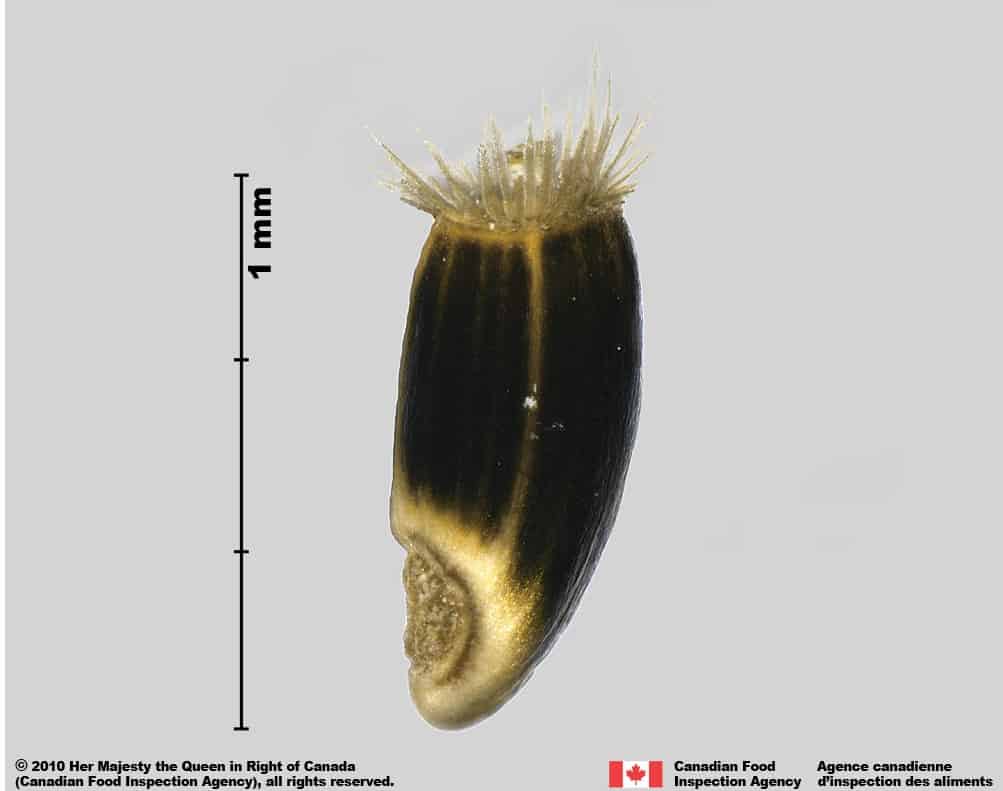Centaurea stoebe
Explore More :
Explore plus :
Overview
Aperçu
Regulation :
Remarques Réglementation:
- CFIA Weed Seeds Order - Class 1: Prohibited Noxious Weed Seeds
- Quarantine lists of countries e.g. India *may be updated without notice
Regulation Notes:
Prohibited Noxious, Class 1 in the Canadian Weed Seeds Order (2016) under the Seeds Act. All imported and domestic seed must be free of Prohibited Noxious weed seeds.
Distribution :
Répartition :
Native to parts of Europe and widely naturalized in others (USDA-ARS 2020). Introduced in Canada and the United States and Australia and New Zealand (CABI 2020; USDA-ARS 2020). Occurs in Canadian provinces of Alberta, British Columbia, New Brunswick, Nova Scotia, Ontario, Quebec, Saskatchewan, Yukon (Brouillet et al. 2010+).
Habitat and Crop Association :
Habitat et Cultures Associées :
Rangelands, grasslands, roadsides, riverbanks and disturbed areas (CABI 2020). Reported as a weed of Medicago sativa (alfalfa) but not usually associated with crop production (CABI 2020).
Economic Use, cultivation area, and Weed Association :
Utilisation économique, zone de culture et association de mauvaises herbes :
Duration of Life Cycle :
Durée du cycle vital:
Perennial
Dispersal Unit Type :
Type d’unité de dispersion :
Achene
General Information
RENSEIGNEMENTS GÉNÉRAUX
Centaurea stoebe was accidentally introduced to North America in contaminated Medicago sativa (alfalfa) and Trifolium spp. (clover) seed in the late 1800s (Ochsmann 2001).
C. stoebe can thrive over a wide range of climate and soil conditions although it prefers well-drained, light to coarse textured soils (CABI 2020). Achenes are dispersed close to the plant, and may be carried a short distance attached to animals, or longer distances by water or vehicle activity (Watson and Renney 1974; Sheley et al. 1998).
.
Centaurea stoebe infestation (Leslie J. Mehrhoff, University of Connecticut, Bugwood.org)
Identification
Identification
-
Achene
Size
- Achene length*: 1.8 – 3.1 mm; width: 0.8 – 1.3 mm
*Note: minimum and maximum of 20 achenes in a normal range of this species using image measurement (ISMA 2020)
Shape
- Achene oblong shaped with a narrow, notched end and a wider truncate end with a pappus, laterally compressed
Surface Texture
- Achene surface is smooth, can have scattered surface hairs that are generally removed during processing
Colour
- Achene colour varies from dull or shining light yellow, light brown, brown or dark greenish-brown with a wide, light yellow central stripe, may have additional thin stripes to either side
Other Features
Pappus
- Pappus length: up to 5.0 mm (FNA 1993+)
Achene end with pappus
- A small style remnant is present in the center of the truncate end
- The rim around the truncate end may be lighter than or the same as the achene’s dominant colour
Achene end without pappus
- The side notch at the end attached to the flower head is deeper and longer compared to similar Centaurea species.
- The area around the side notch is generally shiny or glossy light yellow
- Tissue (elaiosome) generally present in notch, may be removed during processing

Spotted knapweed (Centaurea stoebe) achenes






-
Seed
Size
- Seed size similar to achene size
Shape
- Seed is oblong shaped
Surface Texture
- Seed surface is smooth
Colour
- Seed is light yellow coloured
Other Features
- Seed coat thin, reddish-brown, adhering to the fruit wall
-
Embryo
Size
- The embryo fills the seed
Shape
- Embryo is spatulate, axial position
Endosperm
- Endosperm absent, nutritive tissue stored in the cotyledons
Other Features
- Cotyledons are fleshy and soft-textured
Identification Tips
CONSEILS POUR L’IDENTIFICATION
The achenes are generally distinguished from similar species by their relatively large side notch, a well-developed, persistent pappus, with light yellow coloured lines and tissue in the side notch.

Spotted knapweed (Centaurea stoebe) achene




Additional Botany Information
AUTRES RENSEIGNEMENTS BOTANIQUES
Flowers/Inflorescence
- Flower heads oval shaped, flowers pink, purple or rarely white (FNA 1993+)
- Involucral bracts are egg-shaped or oblong, with prominent nerves and dark tips
- The bract edges near the top are divided into several narrow segments
- The bracts protect the seeds as they develop, and disperse them through a hole at the end of the involucre (Watson and Renney 1974).

Centaurea stoebe flower (Rob Routledge, Sault College, Bugwood.org)




Similar Species
ESPÈCES SEMBLABLES
Similar species are based on a study of seed morphology of various species, and those with similar dispersal units are identified. The study is limited by physical specimen and literature availability at the time of examination, and possibly impacted by the subjectivity of the authors based on their knowledge and experience. Providing similar species information for seed identification is to make users aware of similarities that could possibly result in misidentification.
Centaurea diffusa Lam. (diffuse knapweed)
C. diffusa achenes (length*: 1.4 – 2.6 mm; width: 0.7 – 1.1 mm) are shorter than C. stoebe, with a more shallow side notch. The pappus is generally short or lacking in C. diffusa (length: 0 – 0.5 mm, FNA 1993+) compared to C. stoebe.
*Note: minimum and maximum of 20 achenes in a normal range of this species using image measurement (ISMA 2020)
Click to select species
Cliquez pour sélectionner les espèces

Centaurea diffusa
Comparison Window
Fenêtre de comparaison
MAIN SPECIES
ESPÈCES PRINCIPALES
Centaurea stoebe

Centaurea stoebe
Asteraceae
Spotted knapweed (Centaurea stoebe) achenes
MAIN SPECIES
ESPÈCES PRINCIPALES
Centaurea stoebe

Centaurea stoebe
Asteraceae
Spotted knapweed (Centaurea stoebe) achenes
MAIN SPECIES
ESPÈCES PRINCIPALES
Centaurea stoebe

Centaurea stoebe
Asteraceae
Spotted knapweed (Centaurea stoebe) achene
MAIN SPECIES
ESPÈCES PRINCIPALES
Centaurea stoebe

Centaurea stoebe
Asteraceae
Spotted knapweed (Centaurea stoebe) achene; basal notch
MAIN SPECIES
ESPÈCES PRINCIPALES
Centaurea stoebe

Centaurea stoebe
Asteraceae
Spotted knapweed (Centaurea stoebe) achene, top-down view
MAIN SPECIES
ESPÈCES PRINCIPALES
Centaurea stoebe

Centaurea stoebe
Asteraceae
Spotted knapweed (Centaurea stoebe) achene, close-up
SIMILAR SPECIES
ESPÈCES SEMBLABLES
Centaurea diffusa

Centaurea diffusa
Asteraceae
Diffuse knapweed (Centaurea diffusa) achenes
SIMILAR SPECIES
ESPÈCES SEMBLABLES
Centaurea diffusa

Centaurea diffusa
Asteraceae
Diffuse knapweed (Centaurea diffusa) achenes
SIMILAR SPECIES
ESPÈCES SEMBLABLES
Centaurea diffusa

Centaurea diffusa
Asteraceae
Diffuse knapweed (Centaurea diffusa) achene
SIMILAR SPECIES
ESPÈCES SEMBLABLES
Centaurea diffusa

Centaurea diffusa
Asteraceae
Diffuse knapweed (Centaurea diffusa) achene
SIMILAR SPECIES
ESPÈCES SEMBLABLES
Centaurea diffusa

Centaurea diffusa
Asteraceae
Diffuse knapweed (Centaurea diffusa) achene, basal notch
SIMILAR SPECIES
ESPÈCES SEMBLABLES
Centaurea diffusa

Centaurea diffusa
Asteraceae
Diffuse knapweed (Centaurea diffusa) flower head
Need ID Help?
Besoin d’aide pour l’identification?
Reference(s)
Référence(s)
Brouillet, L., Coursol, F., Meades, S. J., Favreau, M., Anions, M., Bélisle, P. and Desmet, P. 2010+. VASCAN, the database of vascular plants of Canada. http://data.canadensys.net/vascan/ Accessed October 15, 2020.
Centre for Agriculture and Bioscience International (CABI). 2020. Invasive Species Compendium, CAB International, Wallingford, UK. https://www.cabidigitallibrary.org/journal/cabicompendium Accessed October 15, 2020.
Flora of North America (FNA) Editorial Committee, eds. 1993+. Flora of North America North of Mexico [Online]. 22+ vols. New York and Oxford. http://beta.floranorthamerica.org. Accessed December 29, 2022.
Global Biodiversity Information Facility (GBIF) Secretariat. 2022. https://doi.org/10.15468/39omei Accessed via https://www.gbif.org/species/3127727 Accessed December 29, 2022.
Government of Canada (GC). 2016. Canadian Weed Seeds Order. https://laws-lois.justice.gc.ca/eng/regulations/SOR-2016-93/page-2.html (English) https://laws-lois.justice.gc.ca/fra/reglements/DORS-2016-93/page-2.html (French)
International Seed Morphology Association (ISMA). 2020. Method for Seed Size Measurement. Version 1.0. ISMA Publication Guide. https://www.idseed.org/authors/details/method_for_seed_size_measurement.html
Ochsmann, J. 2001. On the taxonomy of spotted knapweed (Centaurea stoebe L.). In: Smith, L., ed. Proceedings, 1st international knapweed symposium of the 21st century; 2001 March 15-16; Coeur d’Alene, ID. Albany, CA: U.S. Department of Agriculture, Agricultural Research Service: 33-41.
Sheley, R. L., Jacobs, J. S., and Carpinelli, M. F. 1998. Distribution, Biology, and Management of Diffuse Knapweed (Centaurea diffusa) and Spotted Knapweed (Centaurea maculosa) Weed Technology. 12: 353-362.
U.S. Department of Agriculture-Agricultural Research Services (USDA-ARS). 2020. Germplasm Resources Information Network (GRIN), https://npgsweb.ars-grin.gov/gringlobal/taxon/taxonomysimple.aspx Accessed October 15, 2020.
Watson, A. K., and Renney , A. J. 1974. The biology of Canadian weeds 6. Centaurea diffusa and C. maculosa. Canadian Journal of Plant Science 54: 687-701.




